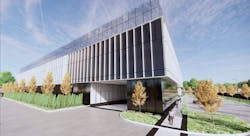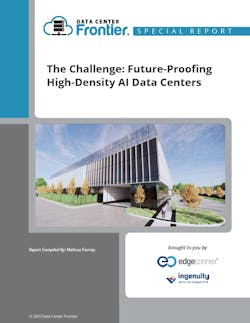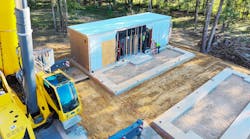This launches our article series on future-proofing high-density AI data centers.
The rapid evolution of artificial intelligence (AI) and high-performance computing (HPC) workloads is placing extraordinary new demands on data center infrastructure worldwide. As organizations adopt advanced GPU- and CPU-driven architectures, they are confronted with unprecedented power densities, variable thermal loads, and increasingly sophisticated cooling, networking, and management systems. These shifts pose fundamental challenges for data center leaders tasked with delivering not only the scale and performance that next-generation AI deployments demand, but also the agility to future-proof investments amid unpredictable technological change.
Modular and flexible architectures — built as a backplane rather than a fixed shell — address these complex challenges by re-envisioning facility design, construction, and operations to adapt to both today’s state-of-the-art rack configurations and the unpredictable evolution of tomorrow’s AI hardware. Incorporating reinforced structures, scalable electrical and cooling systems, and upgrade-ready network capacity allows seamless transitions from air to liquid cooling and prepares for future breakthroughs in density and computational scale.
By emphasizing modularity, scalability, and a robust engineering roadmap, data center tenants are examining new ways to deploy and evolve AI infrastructure with confidence. Whether supporting mixed or dedicated workloads, accommodating both air and liquid cooling, or providing the structural and electrical backbone needed for immersive technologies, facilities must anticipate not only today’s server configurations but also tomorrow’s hardware needs. This enables continuous evolution and minimal disruption to meet performance goals while retaining maximum flexibility.
Implementing & operating new power & cooling technologies at scale
One of the foremost challenges in deploying AI infrastructure at scale is managing the rapid increase in rack power densities. AI servers, especially those incorporating the latest GPU technologies, have seen successive generations push power consumption and heat output beyond traditional data center thresholds. This growth requires more sophisticated cooling innovations and facility adaptations to maintain performance and reliability.
Historically, air cooling sufficed for AI workloads, but as densities surpass air cooling’s practical limits, liquid cooling has become essential. Transitioning from predominantly air-cooled setups to hybrid or fully liquid-cooled environments introduces complexities around facility plumbing, leak detection, thermal storage, and operational protocols. Data centers must be engineered to accommodate this shift smoothly, often balancing a phased approach to support current 70/30 air-to-liquid configurations while provisioning for future states where liquid cooling could account for 95% or more of the thermal management.
NVIDIA and OEM cycles, rapid gen-to-gen density growth
The rapid innovation cycles of key manufacturers such as NVIDIA and server OEMs drive continual increases in compute density and power requirements. Each new generation of processors tends to pack more cores and higher clock speeds into similarly sized server footprints, complicating power and cooling demands within data centers.
Infrastructure providers must maintain close awareness of these cycles to effectively plan capacity and system upgrades ahead of hardware deployments. This involves anticipating new server form factors, varied power delivery needs, different filtration requirements, and fluctuating intake temperatures, all of which influence data center mechanical, electrical, and cooling designs.
A roadmap to supporting the rapid scaling of rack densities
Power densities per rack have surged, with individual racks now demanding power levels ranging from 10kW to upwards of 250kW currently and over 1MW/rack coming in the very near future. For each new generation, leading chip manufacturers like NVIDIA push computational power and efficiency to unprecedented levels, resulting in ever-increasing energy consumption concentrated within smaller physical footprints. Managing this range requires innovative power distribution strategies that deliver precise, scalable, and resilient electrical supply. Decoupling of the data center’s power distribution backplane allows the infrastructure to flexibly accommodate varying power densities across different racks and data halls without requiring major rewiring or facility redesign.
This modular grid provides capacity buffers and adaptable power delivery, customizable for specific server configurations and future hardware upgrades. It delivers the necessary electrical flexibility to meet the demands of current generation servers and a roadmap to even higher densities driven as chips and servers evolve. Careful architectural planning supports these evolving computing requirements without risking bottlenecks or costly downtime.
Flexibility is mission critical
As AI models grow larger and more complex, data centers face accelerated hardware refresh cycles that compress technology deployment timelines. The implication is clear: facilities must be robust enough for today’s intense computing needs and adaptable enough to seamlessly integrate future generations of AI hardware.
Modern data center design is moving away from rigid, fixed architectures toward flexible, modular frameworks. Facilities are dynamically adjusting to shifting workloads, power densities, and cooling requirements without necessitating wholesale redevelopment. Modular design enables incremental scaling, standardized deployments, upgrades, and retrofits.
This flexibility is essential for organizations aiming to maintain agility in a landscape that will continue to see rapid technological change. By anticipating a range of future scenarios, including the adoption of liquid cooling and immersion technologies, modular designs lay the groundwork for sustainable, long-term performance.
Data center as backplane: The ingenuity design philosphy
Central to this approach is a design philosophy that treats the data center as a facility and backplane infrastructure — an adaptable foundation upon which current and future AI and HPC workloads can operate efficiently. It emphasizes structural resilience, scalable electrical systems, and versatile cooling capabilities, all integrated within a unified framework.
Flexible architecture is engineered to serve heterogeneous density and cooling demands within the same data hall. Supporting a blend of air and liquid cooling solutions and incorporating reinforced building elements such as higher ceilings and stronger floors, the facility can host a wide spectrum of AI server configurations. This ensures a facility can absorb the evolving complexity of AI deployments, from today’s mixed workload environments to tomorrow’s potentially fully liquid-cooled, high-density racks. Flexibility in terms of reliability is also important as some customer requirements for AI Training are willing to accept three 9’s of reliability (99.9% availability) and forego things like back-up generators or UPS to accelerate the time and reduce the cost of the overall site.
Design modularity also facilitates steady upgrades aligned with technological advances, allowing new server generations and cooling innovations to be integrated with minimal disruption. In this way, the data center itself becomes a future-proof backplane, capable of evolving in tandem with the AI workloads it supports.
Download the full report, The Challenge: Future Proofing High-Density AI Data Centers, featuring EdgeConneX, to learn more. In our next article, we’ll explore considerations for engineering the next-generation data center today.



